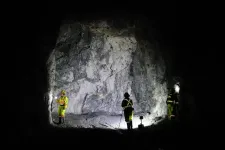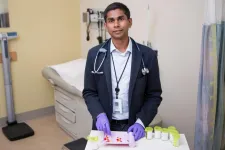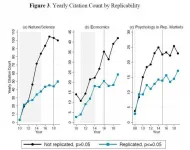Clues from soured milk reveal how gold veins form
For decades scientists have been puzzled by the formation of rare hyper-enriched gold deposits
2021-05-21
(Press-News.org) For decades scientists have been puzzled by the formation of rare hyper-enriched gold deposits in places like Ballarat in Australia, Serra Palada in Brazil, and Red Lake in Ontario. While such deposits typically form over tens to hundreds of thousands of years, these "ultrahigh-grade" deposits can form in years, month, or even days. So how do they form so quickly?
Studying examples of these deposits from the Brucejack Mine in northwestern British Columbia, McGill Professor Anthony Williams-Jones of the Department of Earth and Planetary Sciences and PhD student Duncan McLeish have discovered that these gold deposits form much like soured milk. When milk goes sour, the butterfat particles clump together to form a jelly.
Q&A with Anthony Williams-Jones and Duncan McLeish
What did you set to find out?
Scientists have long known that gold deposits form when hot water flows through rocks, dissolving minute amounts of gold and concentrating it in cracks in the Earth's crust at levels invisible to the naked eye. In rare cases, the cracks are transformed into veins of solid gold centimetres thick. But how do fluids with such low concentrations of gold produce rare ultrahigh-grade gold deposits?
What did you discover?
Our findings solve the paradox of "ultrahigh-grade" or "bonanza" gold formation, which has frustrated scientists for over a century. The paradox of bonanza gold deposits is that there is simply not enough time for them to form, they should not exist, but they do!
As the concentration of gold in hot water is very low, very large volumes of fluid need to flow through the cracks in the Earth's crust to deposit mineable concentrations of gold. This process would require millions of years to fill a single centimetre wide crack with gold, whereas these cracks typically seal in days, months, or years.
Using a powerful electron microscope to observe particles in thin slices of rock, we discovered that bonanza gold deposits form from a fluid much like milk. Milk consists of little butterfat particles that are suspended in water because they repel each other, like the negative ends of two magnets. When the milk goes sour the surface charge breaks down, and the particles clump together to form a jelly. It is the same with gold colloids, which consist of charged nanoparticles of gold which repel each other, but when the charge breaks down, they "flocculate" to form a jelly. This jelly gets trapped in the cracks of rocks to form the ultra high-grade gold veins. The gold colloids are distinctively red and can be made in the lab, whereas solutions of dissolved gold are colourless.
Why are the results important?
We produced the first evidence for gold colloid formation and flocculation in nature and the first images of small veins of gold colloid particles and their flocculated aggregates at the nano-scale. These images document the process by which the cracks are filled with gold and, scaled up through the integration of millions of these small veins, reveal how bonanza veins are formed.
How will this discovery impact the mining industry?
Our results are important to the mineral exploration and mining industry in Canada and around the world. Now that we finally understand how bonanza deposits form, mineral exploration companies will be able to use the results of our work to better explore for bonanza deposits as well as gold deposits. Genetic studies of Canada's most fertile metallogenic districts - such as the one we have just completed at Brucejack - are required to improve our understanding of how world-class mineral deposits form, and thereby develop more effective strategies for their exploration.
What's next for this research?
We suspect that the colloidal processes that operated at Brucejack and other bonanza gold systems may also have operated to form more typical gold deposits. The challenge will be to find suitable material to test this hypothesis. At Brucejack, the next step will be to better understand the reasons why colloid formation and flocculation occurred on the scale observed and reconstruct the geological environment of these processes. We have also been preparing gold colloids in the lab in an attempt to simulate what we discovered at Brucejack.
INFORMATION:
About this study
"Colloidal transport and flocculation are the cause of the hyperenrichment of gold in nature" by Duncan F. McLeish, Anthony E. Williams-Jones, Olga V. Vasyukova, James R. Clark, and Warwick S. Board was published in Proceedings of the National Academy of Sciences of the United States of America.
DOI: https://doi.org/10.1073/pnas.2100689118
About McGill University
Founded in 1821, McGill University is home to exceptional students, faculty, and staff from across Canada and around the world. It is consistently ranked as one of the top universities, both nationally and internationally. It is a world-renowned institution of higher learning with research activities spanning two campuses, 11 faculties, 13 professional schools, 300 programs of study and over 40,000 students, including more than 10,200 graduate students.??
McGill's commitment to sustainability reaches back several decades and spans scales from local to global. The sustainability declarations that we have signed affirm our role in helping to shape a future where people and the planet can flourish.
https://www.mcgill.ca/newsroom/
[Attachments] See images for this press release:

ELSE PRESS RELEASES FROM THIS DATE:
2021-05-21
A team of researchers led by scientists at UC Santa Cruz analyzed data from 3,212 camera traps to show how human disturbance could be shifting the makeup of mammal communities across North America.
The new study, published in the journal Global Change Biology, builds upon the team's prior work observing how wildlife in the Santa Cruz Mountains respond to human disturbance. Local observations, for example, have shown that species like pumas and bobcats are less likely to be active in areas where humans are present, while deer and wood rats become bolder and more active. But it's difficult to generalize findings like these across larger geographic areas because human-wildlife interactions are often regionally unique.
So, to get a continent-wide ...
2021-05-21
Free access to essential medicines increases patient adherence to taking medication by 35 per cent and reduces total health spending by an average of over $1,000 per patient per year, according to a two-year study that tested the effects of providing patients with free and convenient access to a carefully selected set of medications.
The findings, published May 21 in PLOS Medicine, come as advocates urge Canada to carve a path toward single-payer, public pharmacare. Canada is the only country with universal healthcare that does not have a universal pharmacare program.
A group of researchers led by St. Michael's Hospital of Unity Health ...
2021-05-21
Papers in leading psychology, economic and science journals that fail to replicate and therefore are less likely to be true are often the most cited papers in academic research, according to a new study by the University of California San Diego's Rady School of Management.
Published in Science Advances, the paper explores the ongoing "replication crisis" in which researchers have discovered that many findings in the fields of social sciences and medicine don't hold up when other researchers try to repeat the experiments.
The paper reveals that findings from studies that ...
2021-05-21
The human body is constantly exposed to various environmental actors, from viruses to bacteria to fungi, but most of these microbial organisms provoke little or no response from our skin, which is charged with monitoring and protecting from external dangers.
Until now, researchers weren't quite sure how that happened -- and why our skin wasn't constantly alarmed and inflamed.
In a study published May 21, 2021 in Science Immunology, scientists at University of California San Diego School of Medicine identify and describe two enzymes responsible for protecting our skin and body's overall health from countless potential microbial intruders. These enzymes, called histone deacetylases (HDACs), inhibit the body's inflammatory response in the skin.
"We have figured ...
2021-05-21
Ionization energy is one of the most important physicochemical parameters. It is defined in terms of the amount of energy required to rip an electron from an atom. The dependence of the ionization energy on the atomic number determines the periodic law of chemical elements, which is assumed to be fundamentally constant. Based on the previously predicted effect of changing the electron mass, the research team showed that the ionization energy of atoms placed in photonic crystals with an ultrahigh refractive index can be significantly changed.
Photonic crystals ...
2021-05-21
Despite the increasing frequency and severity of floods, storms, wildfires and other natural hazards, some firms in disaster-prone areas prepare while others do not.
That issue was examined in a new study by Jennifer Oetzel, professor, American University and Chang Hoon Oh, William & Judy Docking Professor of Strategy, University of Kansas published in the Strategic Management Journal (SMJ).
"Due to the increased frequency and severity of floods, storms, epidemics, wildfires and other natural hazards anticipated over the coming decades (according to the National Oceanic and Atmospheric Administration), there is growing pressure on managers and their ...
2021-05-21
DALLAS - May 21, 2021 - One member of a large protein family that is known to stop the spread of bacterial infections by prompting infected human cells to self-destruct appears to kill the infectious bacteria instead, a new study led by UT Southwestern scientists shows. However, some bacteria have their own mechanism to thwart this attack, nullifying the deadly protein by tagging it for destruction.
The findings, published online today in Cell, could lead to new antibiotics to fight bacterial infections. And insight into this cellular conflict could shed light on a number of other conditions in which this protein is involved, including asthma, Type 1 diabetes, primary biliary cirrhosis, and Crohn's disease.
"This ...
2021-05-21
OKLAHOMA CITY AND DENMARK - Campylobacter infection, one of the most common foodborne illnesses in the Western world, can also be spread through sexual contact, according to a new research discovery by an OU Hudson College of Public Health faculty member, working in conjunction with colleagues in Denmark.
The team's research has been published in Emerging Infectious Diseases, a journal published by the Centers for Disease Control and Prevention (CDC), and is the first known study to prove this mode of transmission for Campylobacter. During a time when COVID-19 has dominated news about infectious diseases, the research is a reminder that many other pathogens affect lives around the world every day. The study was led by infectious disease epidemiologist Katrin ...
2021-05-21
Over 20 Indonesian islands mysteriously disappear. One of the world's deadliest criminal syndicates rises to power. Eight cities the size of New York will be built every year for the next three decades. What connects them is sand, embedded in the concrete of nearly all of the world's buildings, roads, and cities, the glass in the windows, laptops and phone screens, and COVID-19 vaccine vials.
The unexamined true costs of sand - broadly, construction aggregates production -- has spurred a group of scientists to call for a stronger focus on understanding the physical dimension of sand use and extraction. They also suggest new ways to achieve economic and environmental justice.
Four years ago, an international group of scientists, including two from Michigan State University (MSU), called ...
2021-05-21
What The Study Did: Medication use among hospitalized patients for COVID-19-related treatment in a large university health care system was examined in this study.
Authors: Jonathan H. Watanabe, Pharm.D., Ph.D., of the University of California, Irvine, School of Pharmacy & Pharmaceutical Sciences, is the corresponding author.
To access the embargoed study: Visit our For The Media website at this link https://media.jamanetwork.com/
(doi:10.1001/jamanetworkopen.2021.10775)
Editor's Note: Please see the article for additional information, including other authors, author contributions and affiliations, conflict of interest and financial disclosures, and funding and support.
INFORMATION:
Media advisory: ...
LAST 30 PRESS RELEASES:
[Press-News.org] Clues from soured milk reveal how gold veins form
For decades scientists have been puzzled by the formation of rare hyper-enriched gold deposits






